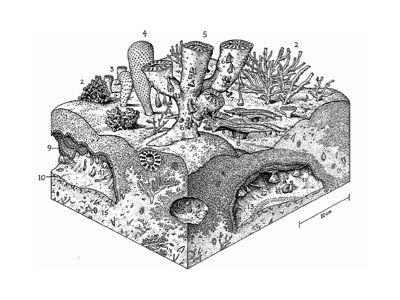
This image is an Early Cambrian period reef community, taken from this page about the Early Cambrian. It’s from Rachel Wood’s The Ecological Evolution of Reefs, and I just love the quality of the the image. Diagrammatic and illustrative.
Roughly 540 million years ago, the Early Cambrian epoch started. Over 30 million years, there was a huge explosion of life. Most of the current phyla – types of life – we have today evolved in that period. This was the Cambrian Explosion.
There’s one theory, that’s put forward in a book called In the Blink of an Eye, that says this explosion was due to a big arms race, due to the evolution of the first eye. The proto-oceans of early Earth, a half billion years ago, were dirty, and they slowly cleared. At a certain point, animals (or whatever we should call them) moved through the oceans to find different chemical concentrations, towards more carbon or whatever. All detection was local. It was all done with the surface of the body, including the absorption of these same chemicals.
But when the oceans cleared of dust, light could penetrate. And when light could penetrate, animals could perceive information from further away than they could grasp. Reach suddenly exceeded grasp! That meant grasp should try to increase too, and movement, then reach would need to get better, for competition’s sake. Thus we suddenly need things like moving quickly, camouflage, deduction, object tracking, theories. You need theories to figure out the visual data!
Unfortunately, people who do actual science from that era, a chap named Simon Conway Morris in particular, have fairly conclusively said this theory is bunk. Oh well. It doesn’t matter. Where is my vision on my phone? Or on my computer? I’m stumbling around in the dark here.